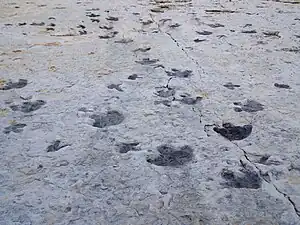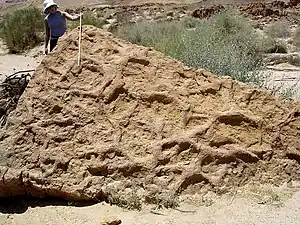Ichnology
Ichnology is the study of trace fossils of once-living things.[1]


Burrows, trackways, trails and borings are all examples of traces made by organisms.[1] Scientists study traces made by plants and animals to try to determine their behavior.[2] An ichnologist is a scientist whose area of study and research is ichnology.
A species name given to a fossil is called an ichnospecies. It is written in italics with a lower case initial. It is shown to be an ichnospecies by the abbreviation "isp".[3]
Examples
- Later Cambrian trace fossils from intertidal settings include Protichnites and Climactichnites, and others.
- Mesozoic dinosaur footprints including Ichnotaxon such as Grallator and Atreipus (bipedal theropods) and Anomoepus.
- Triassic to Recent termite mounds, which can be several square kilometers of sediment
- Possible Avian footprints such as Saurexallopus.
References
- "ichnology". Dictionary.com. Retrieved February 6, 2017.
- "What is Ichnology?". Emery College of Arts and Sciences. Archived from the original on March 18, 2017. Retrieved February 6, 2017.
- ichnospecies. Oxford University Press. 20 March 2008. ISBN 978-0-19-921194-4. Retrieved February 6, 2017.
{{cite book}}:|website=ignored (help)
Other websites
This article is issued from Wikipedia. The text is licensed under Creative Commons - Attribution - Sharealike. Additional terms may apply for the media files.